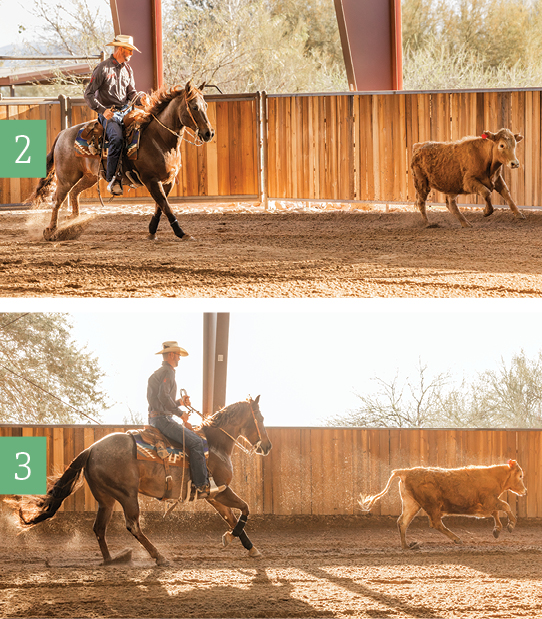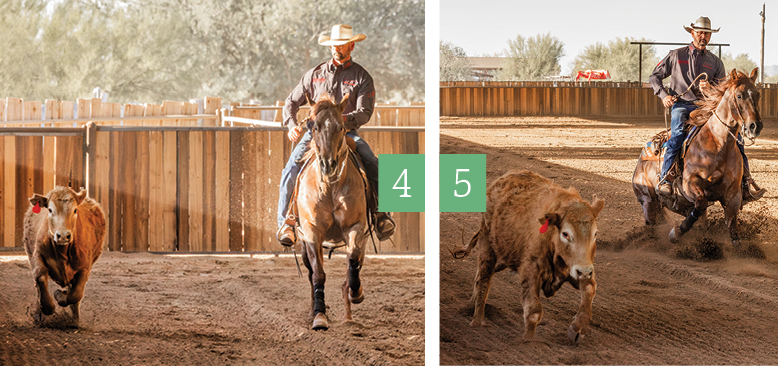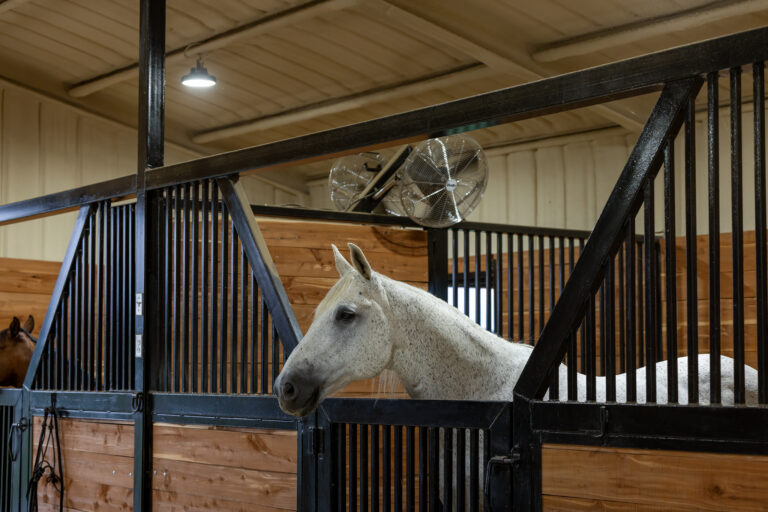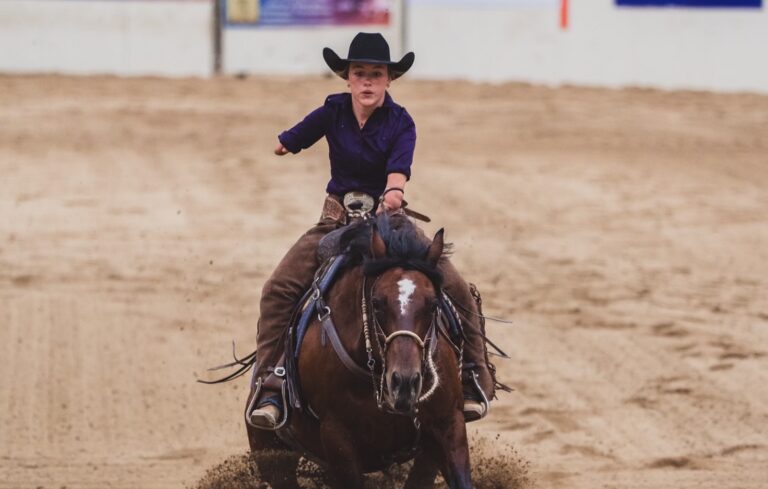Learn how the box-drive class can build your confidence and refine your skills before tackling full fence runs. Get ready to drive, box, and position your way to success in the arena with help from reined cow horse trainer Shadd Parkinson.

When the NRCHA introduced a provisional class called beginning fence work in 2020, it filled a crucial gap for riders ready to move beyond boxing but not yet ready for full fence runs. Now officially known as box-drive, this class has become a popular steppingstone for non-pro riders eager to level up their skills in a more approachable way.
The box-drive class gives competitors the opportunity to build confidence by boxing a cow, driving it down the fence, and boxing again, without the added complexity of making turns or circling. It’s a class designed to develop feel, timing, and cow sense in a controlled setting while still capturing the thrill of working down the fence.
In this article, we’ll break down what the box-drive class entails, what to expect when you step into the arena, and how to prepare your horse at home, so you can enter the show pen confident, capable, and ready to ride with purpose.
Building Blocks of Fence Work
I like to look at the box-drive as a transition class for riders who are just getting comfortable running next to a cow going down the fence. It’s a great event for riders who are looking to build confidence before going down the fence. It’s also a great class for riders who don’t ever plan to go down the fence but would like to do more than boxing.
It gives you the opportunity to learn the basic principles of fence work and get comfortable with taking a cow through the corner all while learning positioning down the fence without having to make a turn or do any circling in the middle of the pen.
It also sharpens your ability to read a cow and understand how to manage its “bubble.” Does your cow need you to get up close to create movement, or is it more sensitive and responsive to subtle pressure? The box-drive helps you develop that feel so that you know when to push, when to back off, and how to stay in control of the situation without overdoing it.
Learn Shadd Parkinson’s Tips on Pattern Placement
Breaking Down the Box-Drive
While the box-drive is designed to simulate going down the fence, it does differ a little bit with how you work the cow and where you position yourself.

Step 1: When you’re in a boxing class, you know that your only job is to hold that cow on the end of the arena it came out of and make as many turns as possible in the allowed time. But when you do the box-drive class, you only have one minute and 45 seconds to work the cow, so you must be strategic with your time.
When the cow comes into the arena, you need to use this time to feel out your cow’s bubble, while also showcasing to the judge that you’re able to contain the cow at the end of the arena. You need to feel how much pressure it takes for that cow to drive, and how much pressure you need to take off the cow to stop it. Then you start shrinking that bubble down until the cow accepts you being next to it. Keep in mind that to drive your cow forward you need to drive from its hip. To stop the cow, you need to get to the head of the cow.
Step 2: Once your horse is locked onto the cow and you have a solid read on it, it’s time to take it down the fence. Ideally, you want to box the cow toward the opposite side of the arena from the direction you plan to go. For example, if you’re going down the right fence, position the cow closer to the left side of the short wall before turning it to go down the fence. This gives you time and space to get into position and drive the cow smoothly through the corner.
Avoid trying to send the cow down the fence when it’s already near the corner you plan on going through; this will most likely put you out of position and make it tough to maintain proper control. And, choose the fence opposite the judges so they can clearly see how you’re working the cow.
Stay connected to the cow’s hip and focus on driving it to the middle marker while keeping it tight to the fence. This part of the run is all about demonstrating control—a great fence run is usually all about positioning. If you get too far ahead, you risk shutting down the cow’s forward motion or accidentally turning it.

Step 3: Once you drive the cow past the middle marker, it’s time to slow your horse’s speed down and get in position to start boxing on the opposite end of the arena. Photos by Kirsten Ziegler
Step 3: As you approach the middle marker, it’s time start easing off the pressure. This is where your horse’s ability to rate the cow—adjusting his speed up or down—is essential. By gradually slowing down and shifting your position, you give the cow the opportunity to travel to the other end of the arena. At the same time, you’re setting yourself up to box the cow again.
Step 4: By now, you should have a good read on your cow. If your cow is sensitive, you’re not going to need to get as close to stop and turn it. But if your cow is comfortable with more pressure, just know that you’re going to have to get a little closer to get the cow to stop and turn. You need to once again demonstrate the ability to hold the cow on that end of the arena and make a couple of turns.
Remember, the clock is ticking, but don’t let that leave you in a rush! If you try to rush through the corner, chances are you’re going to put yourself in the wrong spot or put too much pressure on the cow too fast. This pressure will cause the cow to shoot through the corner, and you’ll lose working control. Take your time, and set yourself up so you can get to the hip and properly move the cow through the corner.

Step 5: I make sure I get past the middle marker, wait for the whistle from the judge letting me know my run is complete, and then ask my horse for a nice stop to end the run. Photos by Kirsten Ziegler
Step 5: Once your cow is set up to go through the corner, it’s time to send it back down the fence to the other end of the arena where you started. Just like before, drive the cow past the middle marker. But this time—once you get past the middle marker and the whistle blows (or time expires on the clock) signifying the completion of the run—you can ask for a nice stop. Spatial awareness is key! Make sure that you don’t stop too early. Pay attention to where you are in the arena and listen for the whistle. You don’t want to end your run in the penalty box because you stopped too early.
Practice with Purpose
Before you can expect success in the show pen, especially in a fast-paced class like box-drive, you need to lay a solid foundation at home.
Focus on fundamentals: Just like any other reined cow horse event, body control is the key to having a successful run. For example, if you’re in the show pen and you need to figure out what your cow’s bubble is, you need to be able to move your horse away from the cow to soften the pressure.
When you’re at home, take time to check in with your horse to see if he’s responsive to your leg and hand cues. Work an imaginary cow, and see how your horse responds when you go to move his ribcage and hip away from the “cow.” Is he willingly to move over or does he lean into your leg? When you go to your hand, does your horse willingly move his shoulders over or does he get stiff in his front end?
If you ride your horse and you feel like he’s leaning into your leg or getting stuck in his front end, focus less on actual cow work and go back to the fundamentals. While it’s always fun to be able to work cattle, you’ll thank yourself in the long run if you spend time working on body control.
Get comfortable with speed: Another key element to prepare for this class—and eventually going down the fence—is practicing your speed control. Being able to go fast and then come back down to a slower pace in an instant builds the confidence you’ll need to handle a cow in a fast-paced environment. Once you trust that your horse will come back to you when things get quick, you’ll be able to stay mentally sharp in the pen instead of worrying whether your horse can keep up or slow down.
Practice this at home by using visual markers in your arena, whether it’s a banner, a post, or even a notch in the fence. Ask your horse to go forward as if you’re driving a cow down the fence. When you reach that marker, ask him to come back down to a steady, collected lope. If he responds right away, great—you’re on the right track. But if he doesn’t, that’s your cue to go back to the basics and work on getting a clear response from your seat and hands.
I also like to add small circles into these speed transition drills. Once I bring my horse down at the marker, I’ll guide him into a tight circle, almost like loping around a barrel. This helps lift his shoulders and maintain cadence in his movement, reinforcing balance and control.
Ready to Box-Drive?
The box-drive class might be a steppingstone class, but don’t underestimate its value; it’s one of the best ways to build confidence, improve your timing, and lay the groundwork for future success in reined cow horse events. Whether you’re preparing for your first run or looking to fine-tune your approach, focusing on the fundamentals and learning to read your cow will go a long way toward helping you feel in control in the show pen.
Remember, every great fence run starts with good position, solid body control, and a clear understanding of pressure and release. So take your time at home, build that trust with your horse, and go into your next box-drive run with purpose. You’ve got the tools, now it’s time to put them to work.
Learn the fundamentals of cow work by subscribing to Ride TV.



![[Aggregator] Downloaded image for imported item #35942](https://s3.amazonaws.com/wp-s3-horseandrider.com/wp-content/uploads/2025/10/20105738/EDCC-Unbranded-14-300x200-1.jpeg)
